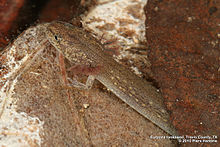 Nathan F. Bendik of the City of Austin’s Watershed Protection Department and Andrew Gluesenkamp, the state herpetologist with Texas Parks and Wildlife Department, were not surprised when the tails of an endangered salamander, Eurycea tonkawae, were thinner when measured during a drought.
Nathan F. Bendik of the City of Austin’s Watershed Protection Department and Andrew Gluesenkamp, the state herpetologist with Texas Parks and Wildlife Department, were not surprised when the tails of an endangered salamander, Eurycea tonkawae, were thinner when measured during a drought.
Their mark-and-recapture survey was able to compare measurements of individuals, not just the population as a whole of this spring-dwelling salamander. They knew that the salamanders store fat in their tails, and that when times are tough, the tails are thinner.
It was a surprise, however, that the total length of the salamanders shrank during the drought. Once the water flow in the spring resumed, however, the salamanders grew again.
Their observations are now an article in the Journal of Zoology. Read the abstract here. The full article requires a subscription or fee.
Photo by Piers Hendrie of a Jollyville Plateau Salamander (Eurycea tonkawae), Travis County, Texas. Used through Wikimedia Commons.

Pingback: Salamanders Shrink in Texas Drought « Philip's Blog
Pingback: Salamanders Shrink in Texas Drought « Philip's Blog